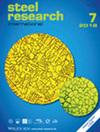Density, Surface Tension, and Viscosity of Liquid Low‐Sulfur Manganese–Boron Steel via Maximum Bubble Pressure and Oscillating Crucible Methods
IF 1.9
3区 材料科学
Q2 METALLURGY & METALLURGICAL ENGINEERING
引用次数: 0
Abstract
In this study, the thermophysical properties of low‐sulfur manganese–boron steel with varying boron and sulfur contents at different temperatures are investigated. Density and surface tension are measured between 1550 and 1650 °C using the maximum bubble pressure method, while viscosity is examined between 1530 and 1570 °C using an improved oscillating crucible viscometer. The methods yield results with low error, consistent with existing literature. The density of the base steel decreases from 7057 ± 25 kg m通过最大气泡压力法和摆动坩埚法测定液态低硫锰硼钢的密度、表面张力和粘度
本研究调查了不同温度下不同硼和硫含量的低硫锰硼钢的热物理性质。采用最大气泡压力法测量了 1550 至 1650 ℃ 之间的密度和表面张力,而采用改进型摆动坩埚粘度计检测了 1530 至 1570 ℃ 之间的粘度。这些方法得出的结果误差很小,与现有文献一致。基体钢的密度从 1550 ℃ 时的 7057 ± 25 kg m-3 降至 1650 ℃ 时的 6843 ± 85 kg m-3。硼(高达 57 ppm)和硫(高达 130 ppm)的加入并不会显著改变密度。硫从 39 ppm 增加到 130 ppm,可将 1650 °C 时的表面张力从 1416 ± 12 mN m-1 降低到 1302 ± 9 mN m-1。硼对表面张力的影响各不相同,可能受到氧等其他元素的影响。粘度范围为 5.74 至 6.44 mPa s,硼和硫的添加造成的变化极小,最大偏差为 8%。这些结果为液态钢加工的模拟、建模、控制和优化提供了宝贵的数据。
本文章由计算机程序翻译,如有差异,请以英文原文为准。
求助全文
约1分钟内获得全文
求助全文
来源期刊

steel research international
工程技术-冶金工程
CiteScore
3.30
自引率
18.20%
发文量
319
审稿时长
1.9 months
期刊介绍:
steel research international is a journal providing a forum for the publication of high-quality manuscripts in areas ranging from process metallurgy and metal forming to materials engineering as well as process control and testing. The emphasis is on steel and on materials involved in steelmaking and the processing of steel, such as refractories and slags.
steel research international welcomes manuscripts describing basic scientific research as well as industrial research. The journal received a further increased, record-high Impact Factor of 1.522 (2018 Journal Impact Factor, Journal Citation Reports (Clarivate Analytics, 2019)).
The journal was formerly well known as "Archiv für das Eisenhüttenwesen" and "steel research"; with effect from January 1, 2006, the former "Scandinavian Journal of Metallurgy" merged with Steel Research International.
Hot Topics:
-Steels for Automotive Applications
-High-strength Steels
-Sustainable steelmaking
-Interstitially Alloyed Steels
-Electromagnetic Processing of Metals
-High Speed Forming
 求助内容:
求助内容: 应助结果提醒方式:
应助结果提醒方式:


